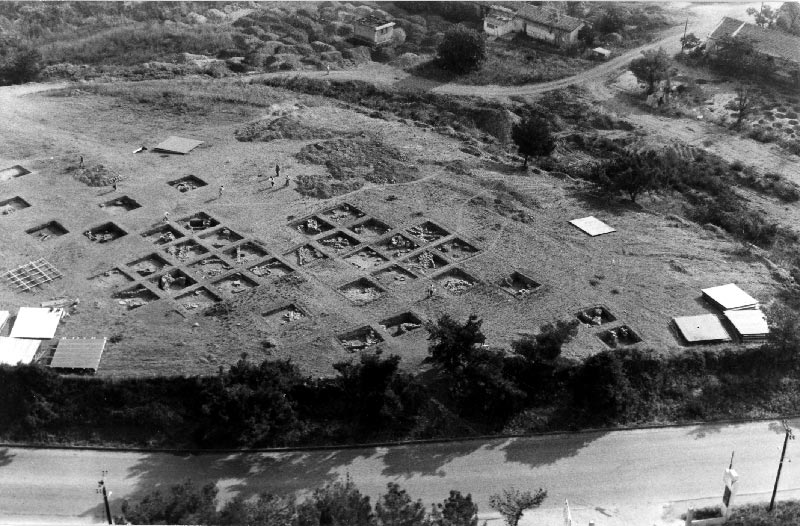Fishing activities and seafood consumption at Karabournaki
The settlement of Karabournaki provides a unique insight into fishing activities and seafood consumption in the Thermaic Gulf in historical times (especially between the 8th and 5th centuries BC), and completes the rich dataset from earlier periods on this region (e.g. Toumba Thessalonikis, Archontiko, some examples in Theodoropoulou 2007, 2008, Θεοδωροπούλου 2014, Βεροπουλίδου 2011, 2014, Βεροπουλίδου et al. 2015).
The inhabitants of the settlement seem to continue a millennia-long tradition of collecting of invertebrates on the sandy shores and brackish zones of the gulf. Coastal resources formed an important complementary foodstuff in several Aegean coastal settlements during the 7th-6th centuries BC (for a gazetteer of sites and bibliography, Theodoropoulou 2017). What makes Karabournaki unique compared to other sites of this period is the exploitation of inland water bodies, such as rivers, as was the case of preceding Neolithic and Bronze Age communities in the Thermaikos Gulf.
The shell material primarily consists of cockles (Cardiidae), accompanied by other common species in the area, such as bittersweets, scallops, horn shells, purple shells, Noah’s arks, telines, razor shells, oysters and thorny oysters. Cuttlefish and crabs were also caught. At least one remain of river mussel (Unio sp.) has been identified.
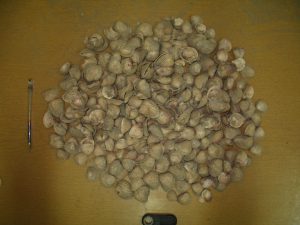
Coastal collecting seems to have been an important and consistent activity, as suggested by significant quantities of shell remains recovered throughout the site (Fig.1). A single pit (trench 22-84b) contained more than 945 valves of the cockle Cerastoderma glaucum, i.e. at least 400 complete shells (Τiverios et al. 2013). These cockles had been carefully selected among the medium and largest individuals available, in order to maximize meat yield.
Some of the shell concentrations found in the settlement, commonly interpreted as food refuse, may rather represent live molluscs stored in jars full of sea water for later consumption, as suggested by combined archaeological and stratigraphical data . Preparation and consumption methods included both opening of valves with a sharp instrument and raw consumption, and steaming/boiling.
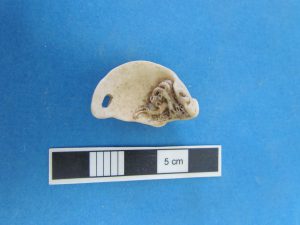
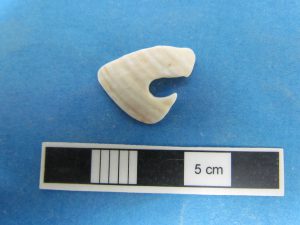
Although the use of the shell of molluscs as raw material is not as common in historical times due to the preference for other materials, namely metals (Theodoropoulou 2017, cf. Theodoropoulou 2014), the shell assemblage from Karabournaki provided some examples of shells used as ornaments, tools or other utilitarian objects (spools, lamps, etc) (Fig. 2,3). A couple of coral branches were also recovered. (Fig. 4)
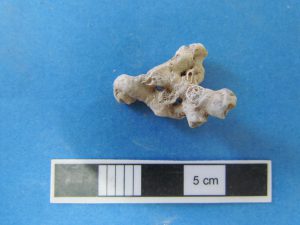
The inhabitants did not only rely on beach-combing but also on fishing, as numerous fish bones suggest. They represent a wide range of fish species, caught with various methods in different fishing grounds:
Most fishing took place in inshore, brackish waters and produced various sea breams (gilthead sea bream, white sea bream, common pandora, dentex, etc.), usually smaller individuals (10-20 cm length). Grey mullets were caught along in the brackish zones. Inshore coastal fishing of solitary demersal fish, such as sea bass or meagre, also took place. The presence of fish, such as the little tunny and the mackerel, suggest a different kind of fishing, in more open waters, using another fishing equipment, and an adapted social organisation, potentially on a seasonal basis. Occasional catches of rays and sharks —or by-catches of seasonal fishing— completed the fish yields. A handful of Cyprinid vertebrae suggest fishing in inland waters.
Karabournaki was definitely a sea-oriented settlement, and marine resources probably played a significant role in everyday subsistence and social organisation.
References
Βεροπουλίδου, Ρ. 2011. Όστρεα από τους οικισμούς του Θερμαϊκού κόλπου. Ανασυνθέτοντας την κατανάλωση των μαλακίων στη Νεολιθική και την Εποχή του Χαλκού (αδημ. διδ. διατρ. ΑΠΘ).
Veropoulidou, R. 2014. Molluscan exploitation in the Neolithic and Bronze Age communities at the former Thermaic Gulf, North Aegean, in G. Touchais, R. Laffineur & F. Rougemont (éds), Physis. L’environnement naturel et la relation homme-milieu dans le monde égéen protohistorique, Actes de la 14e Rencontre égéenne internationale, Paris 11-14 décembre 2012, AEGAEUM 37 (Annales liégeoises et PASPiennes d’archéologie égéenne), Peeters, Leuven, 415-424.
Βεροπουλίδου, Ρ., A. Crézieux, Τ. Θεοδωροπούλου, M. Cheylan, L. Garcia-Petit, & A. Gardeisen. 2015. Η αξιοποίηση των ζωικών πηγών στο Αρχοντικό Γιαννιτσών: στοιχεία περιβάλλοντος και οικονομίας, in Tο Αρχαιολογικό Έργο στη Μακεδονία και Θράκη 25 (2011), 214-221.
Theodoropoulou, T. 2007. L’exploitation des ressources aquatiques en Egée septentrionale aux périodes pré- et protohistoriques (αδημ. διδ. διατρ. Université de Paris 1 Panthéon-Sorbonne).
Τheodoropoulou, T. 2008. Stratégies de pêche en Égée septentrionale au Néolithique et à l’âge du Bronze : paramètres environnementaux et culturels, in P. Béarez, S. Grouard & B. Clavel (eds), Archéologie du poisson, 30 ans d’Archéo-ichthyologie, Hommage aux travaux de Jean Desse et de Nathalie Desse-Berset, Actes des XXVIIIe rencontres d’archéologie et d’histoire d’Antibes, 18-20 octobre 2007, Editions APDCA, Juan-les-Pins, 347-358.
Τheodoropoulou, T. 2014. Dead from the sea: sea-worn shells in Aegean prehistory, in K. Szabó, C. Dupont, V. Dimitrijevic, L. G. Gastélum & N. Serrand (eds), Archaeomalacology: shells in the archaeological record, Proceedings of the 11th ICAZ International Conference, Archaeomalacology Working group, 23-28 August 2010, BAR International Series 2014, Archaeopress, Oxford, 77-90.
Θεοδωροπούλου, T. 2014. Οι αλιευτικές δραστηριότητες στην προϊστορία της Βόρειας Ελλάδας: ένα πανόραμα των αρχαιοζωολογικών δεδομένων, in E. Stefani & A. Dimoula (eds), A century of research in prehistoric Macedonia (Publications of the Museum of Thessaloniki), 453-464.
Theodoropoulou, T. 2017. Regional stories, one sea: towards reconstructing the history/ies of fishing and marine animal exploitation in the early Greek world, in A. Mazarakis-Ainian, A. Alexandridou & X. Charalambidou (eds), Regional stories towards a new perception of the early Greek world, Acts of an international symposium in honour of Professor Jan Bouzek, Volos 19-21 June 2015, University of Thessaly Press, Volos, 669-680.
Tiverios, M., E. Manakidou, D. Tsiafakis, S.-M. Valamoti, T. Theodoropoulou & E. Gatzogia. 2013. Cooking in an Iron Age Pit in Northern Greece: an interdisciplinary approach, in S. Voutsaki, & S.-M. Valamoti (wds), Diet, economy and society in the ancient Greek world. Towards a better integration of archaeology and science. Pharos Suppl. 1, Peeters, Leuven, 205-214.
